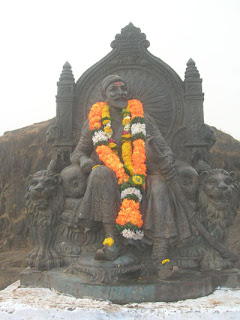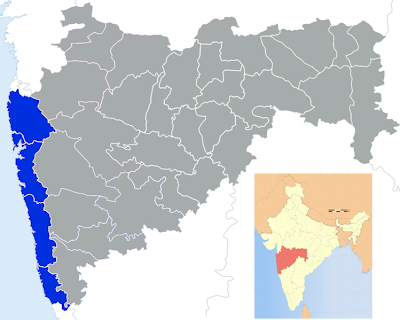The name Maharashtra is believed to be originated from rathi, which means chariot driver. Maharashtra entered the recorded history in the 2nd century BC, with the construction of its first Buddhist caves. The name, Maharashtra first appeared in a 7th century in the account of a contemporary Chinese traveler, Huan Tsang. According to the recorded History, the first Hindu King ruled the state during 6th century, based in Badami.
Shivaji Bhosle, the founder of the Maratha Empire, did a lifelong struggle against the Mughals. By 1680, the year of Shivaji's death, nearly the whole of Deccan belonged to his empire. Shivaji was a great warrior and one of the finest rulers of India, so he holds the highest place in Maratha history.
After the Indian independence in 1947, western Maharashtra and Gujarat were combined as Bombay state. In 1956, the geography of the Bombay state was increased with the inclusion of the predominantly Marathi-speaking regions of Marathwada, from the erstwhile Hyderabad state, and the Vidarbha region from Madhya Pradesh. In 1960, the Gujarati and Marathi linguistic areas of the former Bombay state were separated, and the present Maharashtra state came into being.
In 1961 the Konkan region became a part of the newly formed state of Maharashtra.Creation of the Sindhudurg from the southern areas of the Ratnagiri district.The erstwhile Kolaba district was renamed as Raigad.Under Section 3 of the Maharashtra Land Revenue Code, 1966, the State of Maharashtra was divided into revenue divisions, consisting of one or more districts (excluding the City of Bombay). Similarly, under Section 4(1)(i), the State Government could, by notification in the Official Gazette, specify the districts (excluding the City of Bombay), which constitute a division. Greater Bombay consists of the City of Bombay and the Bombay Suburban District.
The City of Bombay was a separate unit, and was not included in a division and was included in the Konkan Division. The City of Bombay had been directly under the State Government, through the Collector and not through the Commissioner of the Division. That position continued, mainly because the erstwhile Bombay Division was always unwieldy. But recently the Revenue Divisions were for administrative convenience and increasing efficiency, reorganized into six Divisions known as Pune, Nagpur, Aurangabad, Konkan, Nashik and Amravati.
To complete this reorganization it was decided to consider the City of Bombay also to be a district and to create a new Bombay Division immediately consisting of the districts of the City of Bombay and the Bomba Suburban District. This would be a viable and compact unit, with the inclusion of the City of Bombay. Later on the intention is to alter and divide the areas of these districts into two or more districts. The Chief Revenue Authority in this Division, as in other Divisions, would be the Divisional Commissioner.
By the Maharashtra Land Revenue Code (Amendment) Act, 1981 (Mah.XLVII of 1981), the City of Bombay was constituted as a district, and a new DIvision by the name of the Bombay Division had been created, with effect from the 29th July, 1981, consisting of the two district of the City of Bombay and the Bombay Suburban District, which was formerly included in the Konkan Division. It was expected that this would help securing greater administrative efficiency and developmental activities. But the experience gained during the period of more than one and half years had shown that there was no special advantage in having a separate Bombay Division, and on the contrary some administrative problems had been created, and considerable inconvenience was being caused. The transfers and promotions in the Revenue Department such as those of Deputy Collectors and Thasildars were Division-wise. With the creation of a separate Bombay Division, it was not easy to transfer officers from or to the Bombay Division, and this had created problems of postings and promotions of the officers, which had involved Government in litigation.
The Commissioner for the Konkan Division continued to hold charge of the post of the Commissioner of the Bombay Division, as it would have been difficult to justify a separate Officer of that status, with his usual staff, for the limited work load of two districts. There was also the difficulty of finding more office accommodation in Bombay. Government therefore, considered it necessary to take action not to continue the separate Bombay Division and to add the areas of the two districts of the city of Bombay and the Bombay Suburban District to the Konkan Division so that the Konkan Division might in future consist of all the six coastal districts of City of Bombay, Bombay Suburban District, Thane, Raigad, Ratnagiri and Sindhudurg.
Konkan Division, rich in verdant natural beauty, is endowed with a coastline of 720 km and exotic agricultural produce including mango, cashew and beetelnut. It includes Thane, Raigad, Ratnagiri and Sindhudurg districts, besides Mumbai and Mumbai Suburban District. The ancient land has produced galaxy of veterans from different walks of life. Sindhudurg is the second district in the country to achieve 100 per cent literacy. Konkan’s beautiful beaches, greenery, Warli art and sea forts attract a steady stream of visitors. The Konkan Railway is an engineering marvel. The country’s first Atomic Power Plant is at Tarapur in Thane district. Also, it has huge fertiliser units, based on natural gas
![]()
If you like this please Link Back to this article...


















0 comments:
Post a Comment
Note: Only a member of this blog may post a comment.